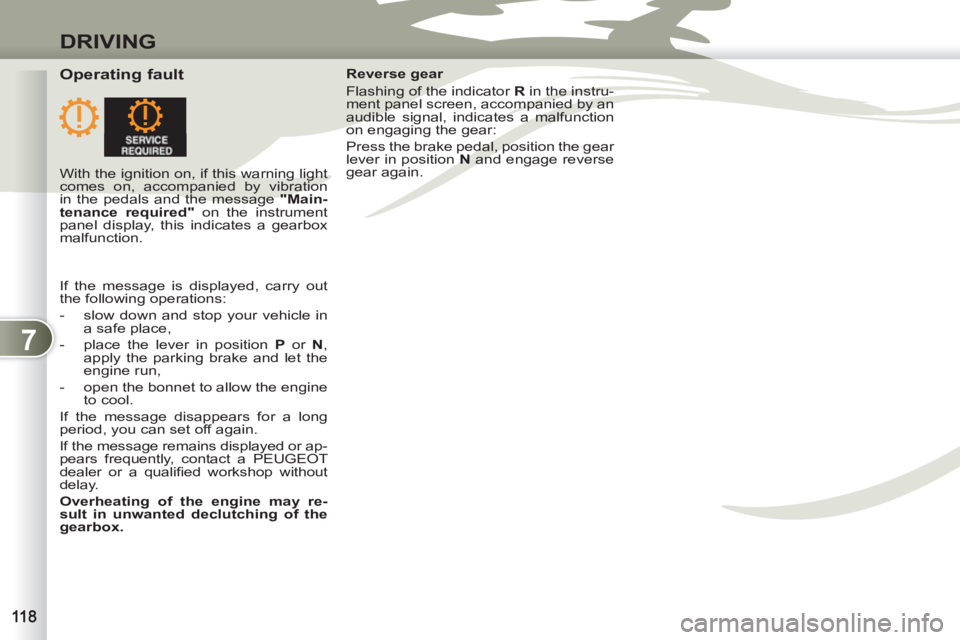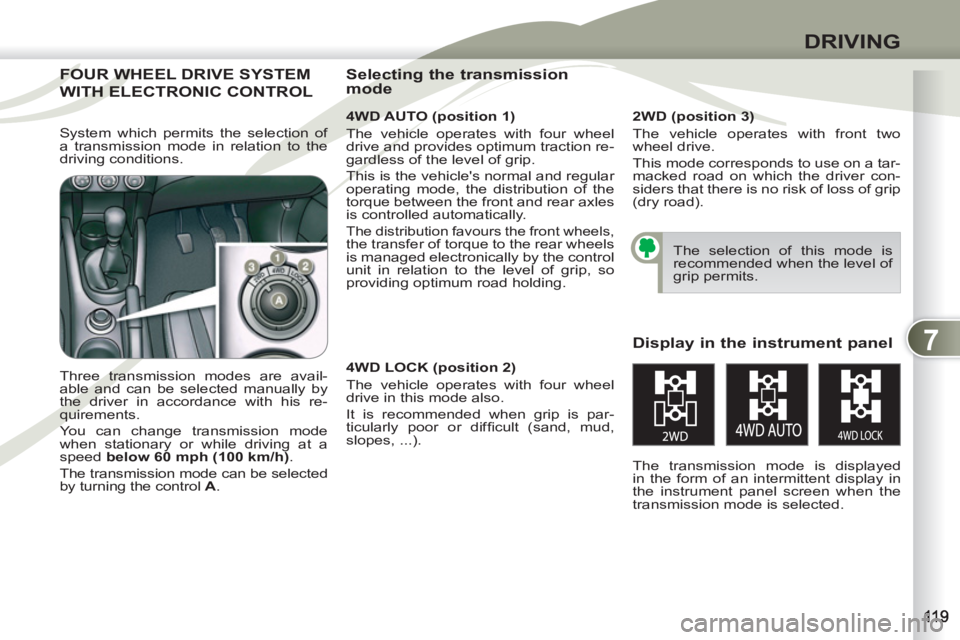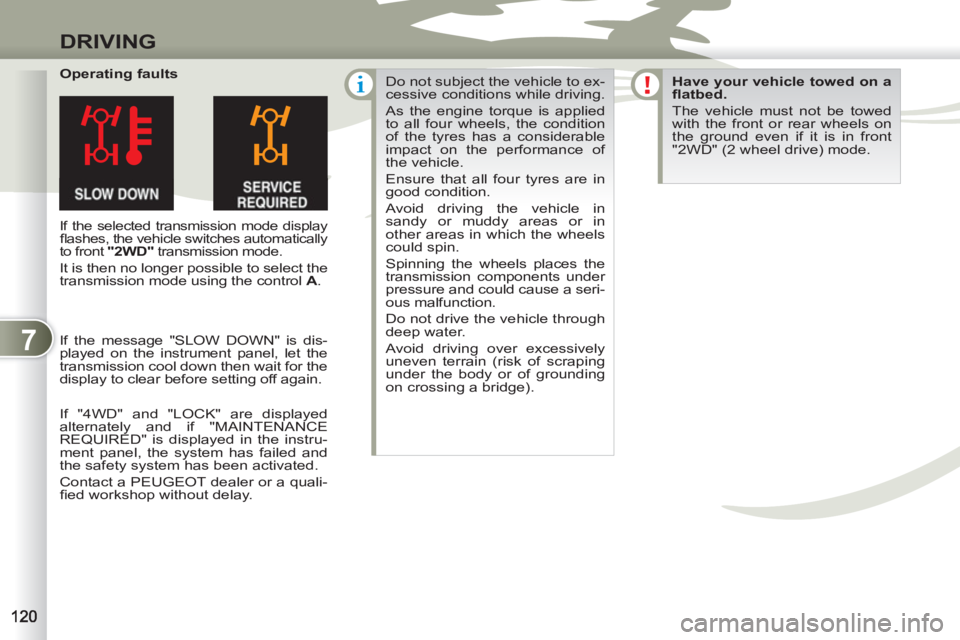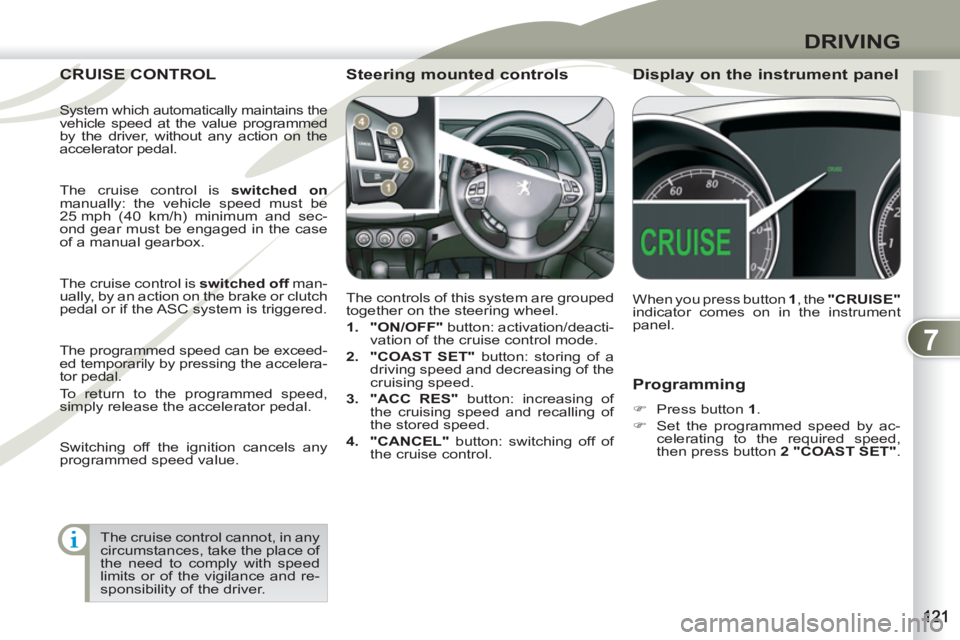2011 PEUGEOT 4007 instrument panel
[x] Cancel search: instrument panelPage 116 of 236

7
DRIVING
Stopping - Starting on a slope
Do not use the accelerator pedal to
immobilise the vehicle on a slope,
apply the parking brake instead.
When starting on a slope, accelerate
gradually while releasing the parking
brake.
Switching to sequential mode
Once you have moved off, you can
switch to sequential mode by selecting
position +/-
.
"D"
disappears and the gears engaged
appear in succession in the instrument
panel screen.
The gear change requests are only car-
ried out if the engine speed permits it.
Take your foot off the accelerator pedal
gently to engage the gear.
Switching to automated mode
Automated mode
After using the sequential mode, you
can return to the automated mode by
selecting position D
.
"D"
appears in the instrument panel
screen.
The gearbox then operates in auto-active
mode, without any action on the part of
the driver.
It continuously selects the gear most
suited to the conditions of:
- driving style,
- road characteristics,
- vehicle load.
To optimise driving comfort and obtain
the most suitable gear, avoid sharp vari-
ations in the pressure on the accelerator
pedal.
Auto sequential mode
In the automated mode, you can take
over control temporarily at any time
using the steering mounted controls.
The use of these controls permits manual
selection of the gears in situations which
require a faster changedown than that
offered in automated mode (arrival at a
roundabout, exit from a car park with a
steep gradient, overtaking...).
Stopping the vehicle
Before switching off the engine, you can:
- move to position N
to leave the
gearbox in neutral.
- leave a gear engaged, such as fi rst
or reverse.
In both cases, you must apply the parking
brake to immobilise the vehicle.
Operating anomaly
With the ignition on, if the message "Slow down"
or "Maintenance required"
ap-
pears in the multifunction screen, this in-
dicates a gearbox malfunction.
When a message is displayed, carry
out the following operations:
- slow down and stop your vehicle in
a safe place,
- place the lever in position N
and let
the engine run,
- open the bonnet to allow the engine
to cool.
If the message disappears for a long
period, you can set off again.
If the message remains displayed or ap-
pears frequently, contact a PEUGEOT
dealer or a qualifi ed workshop without
delay.
Press the brake pedal fi rmly
while starting the engine.
Start the engine. "N"
appears in the in-
strument panel screen.
Select fi rst gear (position D
or +/-
) or
reverse (position R
).
Release the parking brake.
Release the brake pedal then accelerate.
"D"
or "1"
or "R"
appear in the instru-
ment panel screen. The gearbox engages the gear re-
quested if the engine speed permits it.
The gear engaged appears.
To return to the automated mode, press
the back of the "+/OFF"
control for ap-
proximately 2 seconds.
At low speeds, when approaching a
stop or traffi c lights for example, the
gearbox changes down to fi rst gear au-
tomatically.
Page 117 of 236

7
DRIVING
DCS GEARBOX DCS GEA
The six-speed electronically controlled
gearbox offers a choice between the
comfort of automatic regulation or the
pleasure of manual gear changing.
This gearbox has three driving modes:
- a manual
mode for changing of the
gears by the driver using the steering
mounted controls or the gear lever,
- a " Normal
" automatic mode for eco-
nomical control of the gears (everyday
use),
- a " Sport
" automatic mode which
permits a more dynamic style of
driving, with improved acceleration
and optimised engine braking.
Displays in the instrument
panel
When you move the lever in the gate
to select a position, the corresponding
indicator or message is displayed in the
instrument panel.
P.
Park.
R.
Reverse.
N.
Neutral.
D.
Drive (Automatic mode).
NORMAL.
Normal mode.
SPORT.
Sport mode.
1,2,3,4,5,6.
Gear engaged during manual
operation.
Gear lever positions
P
: park.
With your foot on the brake,
this position permits starting of
the vehicle.
To exit position P
, raise the ring on the
gear lever.
R
: reverse gear.
With the vehicle stationary, keep your
foot on the brake pedal and push the
gear lever forwards.
N
: neutral.
With your foot on the brake, this position
also permits starting of the vehicle.
D
: automatic mode.
Move the lever rearwards.
+/-
: manual mode with gear changing
using the lever.
Page 118 of 236

7
DRIVING
Moving off
Select position P
or N
.
Press the brake pedal fi rmly
while starting the engine.
Start the engine.
"P"
or "N"
appears in the instrument
panel screen.
Select fi rst gear ( D
or +/-
) or reverse ( R
).
Release the parking brake.
Release the brake pedal then accelerate.
"D"
or "1"
or "R"
appears in the instru-
ment panel screen.
Manual mode
Using the gear lever
Move the gear lever backwards, then to
the left to select position +/-
.
Push forwards ( +
) to change up.
Push backwards ( -
) to change down.
Using the steering mounted controls
Press behind the "+"
steering mounted
control paddle to change up.
Press behind the "-"
steering mounted
control paddle to change down.
The gear change requests are only car-
ried out if the engine speed permits it.
Take your foot off the accelerator pedal
gently to engage the gear.
At low speeds, when approaching a
stop or traffi c lights for example, the
gearbox changes down to fi rst gear au-
tomatically.
Page 119 of 236

7
DRIVING
"Normal" automatic mode
Select position D
.
"D"
appears in the instrument panel
screen.
The gearbox then operates in automatic
mode, without any action on the part of
the driver.
To optimise driving comfort and obtain
the most suitable gear, avoid sharp vari-
ations in the pressure on the accelerator
pedal.
"Temporary" manual mode
In automatic mode, you can take control
temporarily at any time using the steer-
ing mounted controls.
The use of these controls permits manual
selection of the gears in situations which
require a faster change down than that
offered in automatic mode (arrival at a
roundabout, exit from a car park with a
steep gradient, overtaking...).
The gearbox engages the gear re-
quested if the engine speed permits it.
The gear engaged appears.
To return to the automatic mode, press
the back of the "+/OFF"
control for at
least 2 seconds.
"Sport" automatic mode
From automatic mode, you can engage
"Sport" mode.
With the vehicle moving or stationary,
push the thumb wheel A
forward.
"SPORT"
appears in the instrument
panel screen.
Switching off "Sport" automatic
mode
You can return to "Normal" automatic
mode at any time:
Push the thumbwheel A
rearward once.
Stopping the vehicle
Before switching off the engine, you
must engage position P
or N
to place
the gearbox in neutral.
You must apply the parking brake to im-
mobilise the vehicle.
The gear lever must be in position P
to
remove the ignition key.
Hill start assist
To assist you when starting on a gradi-
ent, your vehicle is fi tted with a system
which immobilises it briefl y (approxi-
mately 2 seconds), the time required to
move your foot from the brake pedal to
the accelerator pedal. This function is
only active when the vehicle has been
completely immobilised with your foot
on the brake pedal and on certain gra-
dients.
Do not get out of the vehicle during
the hill start assist temporary immo-
bilisation phase.
To immobilise the vehicle on a gradient
for a longer period, you must use the
parking brake, not the accelerator.
When starting on a gradient, accelerate
gradually while releasing the parking
brake.
Page 120 of 236

7
DRIVING
Operating fault
Reverse gear
Flashing of the indicator R
in the instru-
ment panel screen, accompanied by an
audible signal, indicates a malfunction
on engaging the gear:
Press the brake pedal, position the gear
lever in position N
and engage reverse
gear again.
With the ignition on, if this warning light
comes on, accompanied by vibration
in the pedals and the message "Main-
tenance required"
on the instrument
panel display, this indicates a gearbox
malfunction.
If the message is displayed, carry out
the following operations:
- slow down and stop your vehicle in
a safe place,
- place the lever in position P
or N
,
apply the parking brake and let the
engine run,
- open the bonnet to allow the engine
to cool.
If the message disappears for a long
period, you can set off again.
If the message remains displayed or ap-
pears frequently, contact a PEUGEOT
dealer or a qualifi ed workshop without
delay.
Overheating of the engine may re-
sult in unwanted declutching of the
gearbox.
Page 121 of 236

7
DRIVING
FOUR WHEEL DRIVE SYSTEMFOUR WH
WITH ELECTRONIC CONTROL WITH E
4WD AUTO (position 1)
The vehicle operates with four wheel
drive and provides optimum traction re-
gardless of the level of grip.
This is the vehicle's normal and regular
operating mode, the distribution of the
torque between the front and rear axles
is controlled automatically.
The distribution favours the front wheels, the transfer of torque to the rear wheels
is managed electronically by the control
unit in relation to the level of grip, so
providing optimum road holding.
Three transmission modes are avail-
able and can be selected manually by
the driver in accordance with his re-
quirements.
You can change transmission mode
when stationary or while driving at a
speed below 60 mph (100 km/h)
.
The transmission mode can be selected
by turning the control A
.
Display in the instrument panel
The transmission mode is displayed
in the form of an intermittent display in
the instrument panel screen when the
transmission mode is selected.
Selecting the transmission
mode
The selection of this mode is
recommended when the level of
grip permits.
2WD (position 3)
The vehicle operates with front two
wheel drive.
This mode corresponds to use on a tar-
macked road on which the driver con-
siders that there is no risk of loss of grip
(dry road).
4WD LOCK (position 2)
The vehicle operates with four wheel
drive in this mode also.
It is recommended when grip is par-
ticularly poor or diffi cult (sand, mud,
slopes, ...). System which permits the selection of
a transmission mode in relation to the
driving conditions.
Page 122 of 236

7
DRIVING
Operating faults
If the selected transmission mode display
fl ashes, the vehicle switches automatically
to front "2WD"
transmission mode.
It is then no longer possible to select the
transmission mode using the control A
. Do not subject the vehicle to ex-
cessive conditions while driving.
As the engine torque is applied
to all four wheels, the condition
of the tyres has a considerable
impact on the performance of
the vehicle.
Ensure that all four tyres are in
good condition.
Avoid driving the vehicle in
sandy or muddy areas or in
other areas in which the wheels
could spin.
Spinning the wheels places the
transmission components under
pressure and could cause a seri-
ous malfunction.
Do not drive the vehicle through
deep water.
Avoid driving over excessively
uneven terrain (risk of scraping
under the body or of grounding
on crossing a bridge).
Have your vehicle towed on a
fl atbed.
The vehicle must not be towed
with the front or rear wheels on
the ground even if it is in front
"2WD" (2 wheel drive) mode.
If the message "SLOW DOWN" is dis-
played on the instrument panel, let the
transmission cool down then wait for the
display to clear before setting off again.
If "4WD" and "LOCK" are displayed
alternately and if "MAINTENANCE
REQUIRED" is displayed in the instru-
ment panel, the system has failed and
the safety system has been activated.
Contact a PEUGEOT dealer or a quali-
fi ed workshop without delay.
Page 123 of 236

7
DRIVING
Programming
�)
Press button 1
.
�)
Set the programmed speed by ac-
celerating to the required speed,
then press button 2 "COAST SET"
.
CRUISE CONTROL CRUISE C
The controls of this system are grouped
together on the steering wheel.
1.
"ON/OFF"
button: activation/deacti-
vation of the cruise control mode.
2.
"COAST SET"
button: storing of a
driving speed and decreasing of the
cruising speed.
3.
"ACC RES"
button: increasing of
the cruising speed and recalling of
the stored speed.
4.
"CANCEL"
button: switching off of
the cruise control.
When you press button 1
, the "CRUISE"
indicator comes on in the instrument
panel.
Steering mounted controls
Display on the instrument panel
The cruise control cannot, in any
circumstances, take the place of
the need to comply with speed
limits or of the vigilance and re-
sponsibility of the driver.
System which automatically maintains the vehicle speed at the value programmed
by the driver, without any action on the
accelerator pedal.
The cruise control is switched on
manually: the vehicle speed must be
25 mph (40 km/h) minimum and sec-
ond gear must be engaged in the case
of a manual gearbox.
The cruise control is switched off
man-
ually, by an action on the brake or clutch
pedal or if the ASC system is triggered.
The programmed speed can be exceed-
ed temporarily by pressing the accelera-
tor pedal.
To return to the programmed speed,
simply release the accelerator pedal.
Switching off the ignition cancels any
programmed speed value.